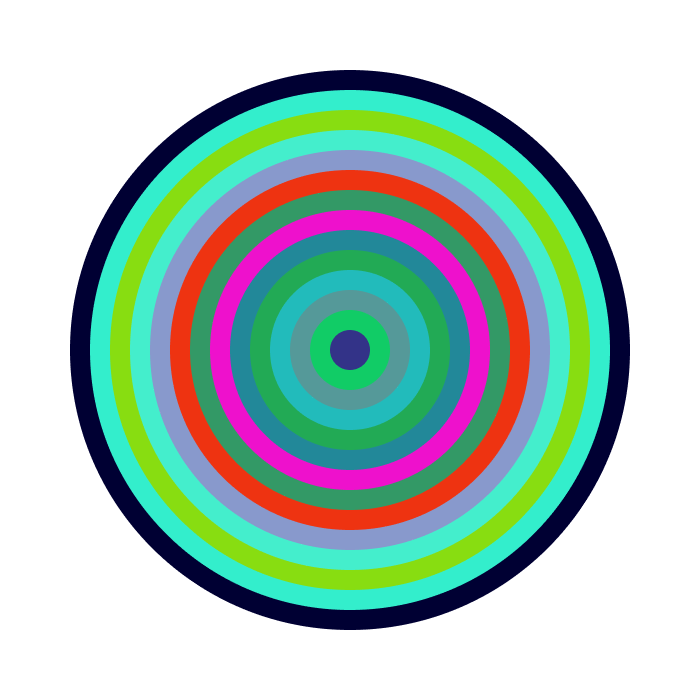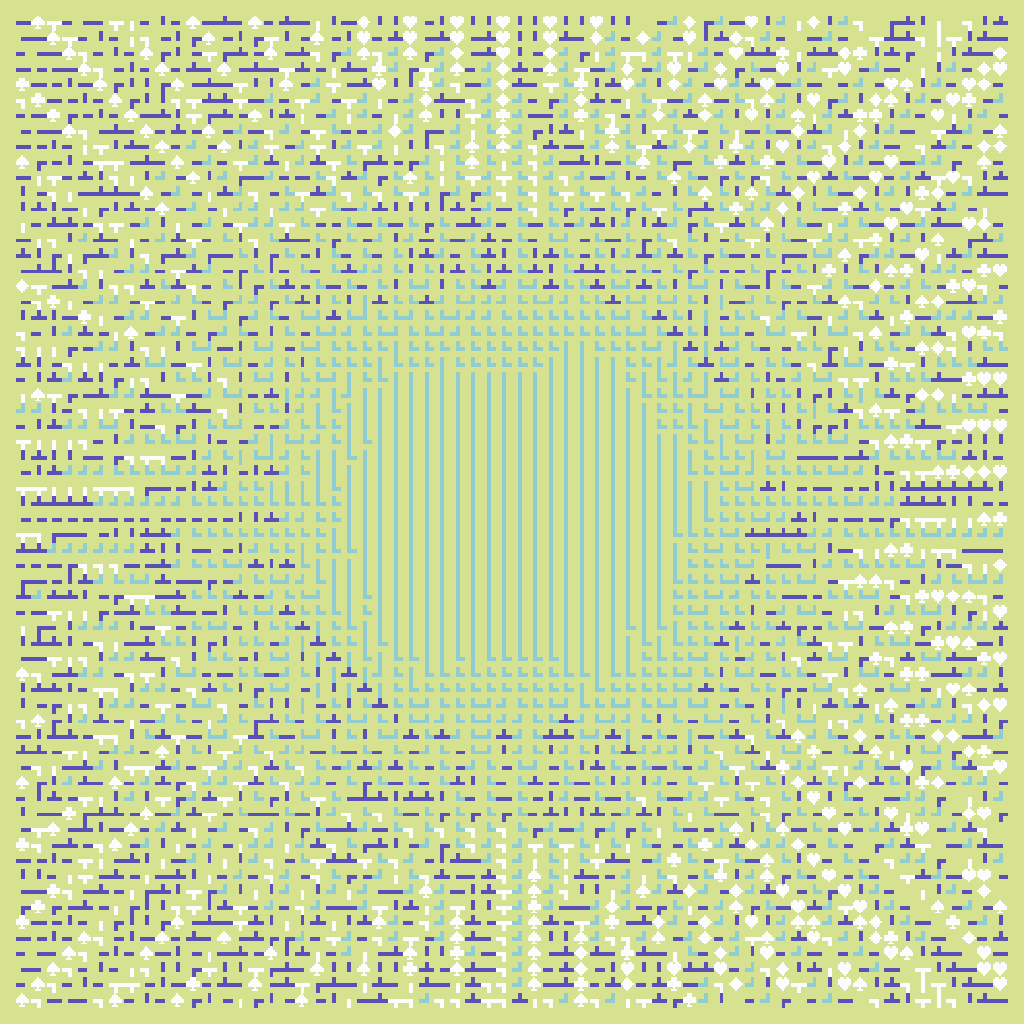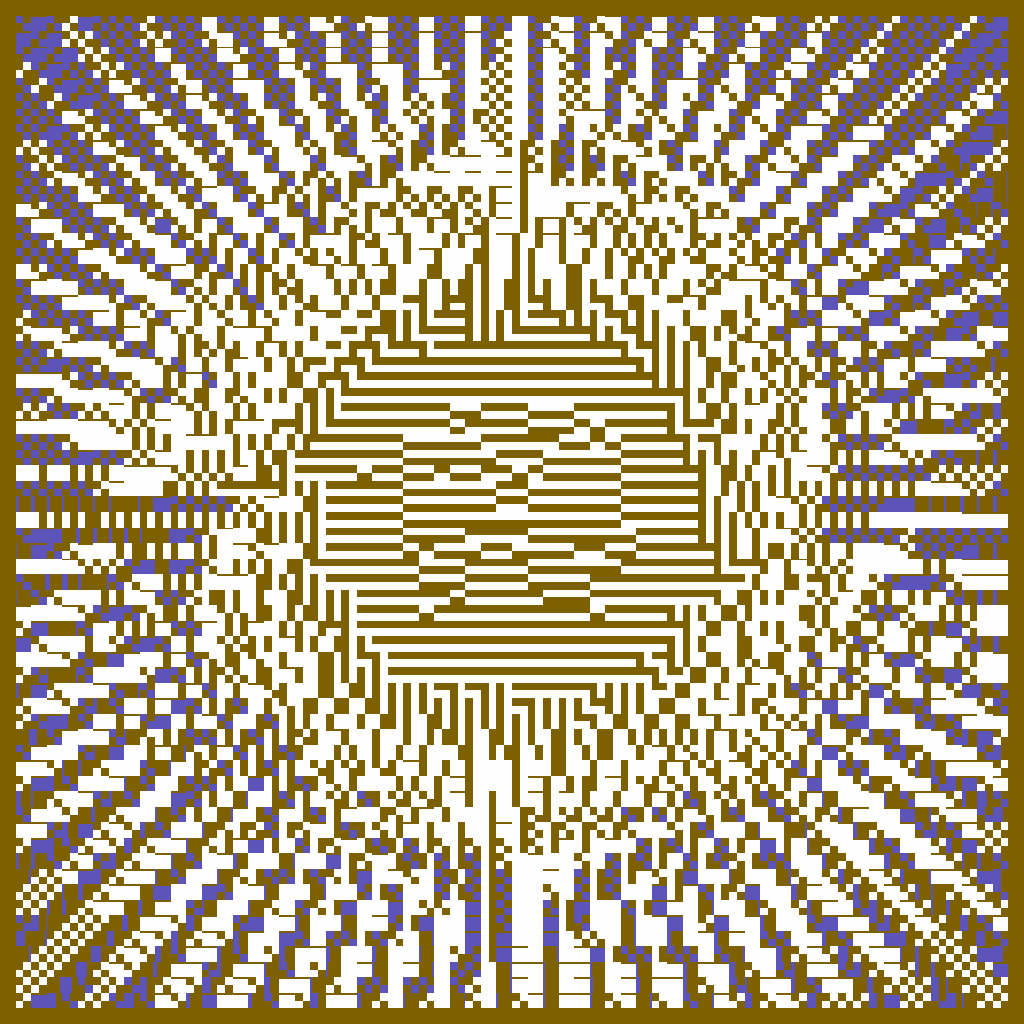Brian L. Frye & Primavera de Filippi
Do NFTs make copyright obsolete? A debate between two legal scholars and artists.

Art Blocks is a blockchain-based platform for generative art that pioneered a new model to make a once-ephemeral genre collectible. When a collector purchases an output of an artist’s algorithm as an NFT, the hash of that transaction on the Ethereum blockchain becomes the seed used for generating an iteration of the work. Not only does the collector receive a unique output of a generative series, but their on-chain activity is an inextricable part of the piece they purchased. The act of collecting completes the work, and also provides an entry to a community of the dozens or hundreds other holders of the same algorithm’s outputs. This collective model appealed to a burgeoning community of artists, patrons, and people who liked to inhabit both roles. Art Blocks has become a leader in the field of generative art, and other platforms—several of which launched this year—have adapted the model for other contexts and purposes. Tonic offers collectors high-quality prints of each digital output; Alba aims to be completely open and accessible site of experimentation; Imagine uses the Ordinal protocol to inscribe artists’ algorithms and their outputs on the Bitcoin blockchain.
Outland convened leaders from two platforms to discuss the current state of the market for generative art, and how their organizations are approaching the challenges and the possibilities of a field transformed by Art Blocks’s innovations. Paul Schmidt is the chief operations officer at fxhash, which launched on the Tezos blockchain in November 2021. It attracted the community of creative coders who, previously active on Hic et Nunc, preferred the atmosphere on Tezos, where the market was more peer-to-peer and less speculative than on Ethereum. Duane King is the creative lead at Highlight, a platform that uses layer 2 solutions to manage transactions off the main network of the Ethereum blockchain to make them more efficient and less expensive—part of an ambition to make creating and collecting generative art a mass activity. Below, Schmidt and King talk about their pursuit of flexibility and openness, the challenges they’ve encountered along the way, and how artists and collectors are responding to an environment with more choices of chains and platforms.



PAUL SCHMIDT For me collecting generative art is about access. I used to go to galleries and look at art, knowing that I could never own it. That barrier to participation made it hard for me to craft my own way of looking at it, of understanding what I like or dislike. So accessibility is big for me. Plus, generative art is how technology gets beautiful again. We’re surrounded by mobile phones and laptop screens constantly putting advertisements in our faces. That makes it hard to see the beauty of technology. With generative art there is some sense of beauty of algorithms, the purity of the code.
DUANE KING I agree with that. I am fascinated with generative art because it’s real-time art. I think that’s of the moment. We’ve become used to websites that transform to fit the device that requests them. It’s normal now to have a set of instructions form content in a liquid manner on demand. Another thing I like about generative art is the questions it raises about the endpoint. Is the art the jpg? The html? Is it JavaScript? Is it webgl? What technologies is it exploiting? What is the substance of the blockchain itself? How does the blockchain work as a medium? And what artistic possibilities does the medium bring?

SCHMIDT The art is in the code but ultimately the collector finishes the work. That’s how it is on fxhash and I’m sure it’s the same on Highlight. It’s not exactly co-creation but there are at least two people involved in producing the work.
KING Yes.
SCHMIDT That’s why generative art NFTs are so different from other NFTs in this space. They’re not just jpgs uploaded to the blockchain. They actually use the blockchain as a means to create an art piece. And I think that’s an important aspect that is often overlooked.
KING You brought up a really good point—that a loop is completed between artist and audience. With traditional art, there’s the art and you look at it. But now as the minter you literally become bound at a contractual level to the creation of that artwork. You’re the patron at the moment of genesis, even if you’re only spending a few dollars. Instead of being some crazy crown prince commissioning artists in the Renaissance you can instead, with a light click, be forever bound to the provenance of that item. And that’s cool.
SCHMIDT Art Blocks was the first to introduce this dynamic. I encountered the concept through Tyler Hobbs and his article on long-form generative art. From the 1960s up until maybe 2020 generative artists would run their algorithms themselves, and from a thousand outputs they’d curate a handful of editions to sell. With long-form generative art, the artist gives some control away, to the algorithm or the collector or the platform. The loss of control can be a positive or a negative depending on where you stand in the value chain. For a collector this can be incredibly exciting. But the loot box principle can also be a problem. People go in wanting something rare. They’re not in it for the art—they want a quick flip. That’s not as prevalent in 2023 as it was in 2021, but still, one of the shortcomings of the long-form model is that art can be devalued or extremely financialized.

KING Clearly Art Blocks was a pioneer in the space. Feral File was doing something similar at the time, but it was on Bitmark, and it was so early that people didn’t even understand how they were making NFTs. Art Blocks not only did a wonderful job of creating some standards for how things should be done, but they also helped everyone understand what it meant to make variable-based or parameter-based artworks. Projects like Hobbs’s Fidenza (2021) really did a good job of educating both Art Blocks and the public in what was possible with the medium. Art Blocks continues to set standards for best-of-class generative art. The challenge of setting standards is that artists like to break rules. So we’re in the space to break the rules. And that’s no offense to Art Blocks. That’s just part of the game of making art.
We offer more than one type of dynamic data input that artists can reference—not just the transaction hash, but wallet address, block hash, timestamps, gas price at time of mint. All these choices can create a new dynamism. It doesn’t have to be just one thing, the hash itself, that generates randomness. It can be the hash plus your wallet address, plus the gas at the time of mint, plus block hash number. We’re also doing things with batch mints. If the contract is aware that you minted, say, ten tokens, we’ll give you ten that are the same color but have variants in other parameters—artists can reward people who batch mint. A combination of layer 2 blockchain pricing accessibility and these dynamic inputs means that people can collect multiples affordably and enjoy a more surprising and dynamic relationship between code and outcome.

SCHMIDT At fxhash we have all the data inputs you mentioned as well. We also give artists the option to sell anything on top of the NFT, in a web-shop fashion, which we call redeemables. Any artist who has a plotter drawing or wants to “port” the algorithm into something like a 3D print, as with Shawn Kemp’s Mini-Dahlias (2023), can sell that directly on top of the NFT to all collectors. Another big thing that differentiates us from Art Blocks is fx(params), which flips the script of how art can be created. For example, Piter Pasma’s Universal Rayhatcher (2023) is an experiment in making the least restrictive parameters possible on fxhash. He made his own mini-version of the platform where collectors can write code of up to 512 characters that uses his algorithms. It allows for much more co-creation and collaboration. Beyond that, use of the hash iteration number as a seed was recently introduced by Julian Hespenheide in FSM (2023), a project exploring self-organization in complex systems that Bright Moments presented with support from fxhash.
I’d like to take a step back and talk about why fxhash was initially created. Ciphrd, the founder, is a generative artist himself. He wanted a way to upload his projects, and the only options at the time were curated platforms. Artists had to apply, meaning only 0.01 percent of artists could share their work in that way. So he created the platform for his own sake, and then released it to the world with an ethos of being completely open and giving artists the most options possible. That includes not being fully on-chain from the beginning and offering the option to upload to IPFS. If you are only uploading on-chain art you’re severely limited by the file size. There are fewer opportunities for dynamic forms of art. Initially we had 10 MB as a file size and have been steadily increasing it ever since.
File size limitations can be an interesting challenge for artists. In the demo scene, people like Piter Pasma would write code with 4 kilobytes—so incredibly limited. However, increasing the storage limit can give artists a much bigger toolbox to draw from. Cyril Diagne created dg5721(), 2022, a tiny neural network with 5721 neurons, that tries to imitate human handwriting by generating new hallucinated digits in real-time, all within 25 megabytes. It’s an immense technical as well as artistic challenge, and one of my favorite projects on fxhash. We included it in our show at Art Basel’s Paris fair last year.

KING It’s important to us to be open and offer options as well. Forcing something to be on-chain is a constraint. It can be really cool from a code-golfing perspective, but not necessarily appropriate for GPU-intensive AI art. You want those artists to have their own outlet for expression as well. We’re passionate about letting artists move through stages of being on-chain. Maybe an artist launches a project on the decentralized storage network Arweave, which helps afford quick rendering across all sorts of services and platforms. It looks good in wallets. It’s fast. But at a certain point if your project is successful you may choose to upgrade it and make it fully on-chain. That’s something you can do retroactively with our service. There’s not a right way to do it. Our aim is to provide a great deal of flexibility for artists because it means that we’ll get new people working in the space, and I think that’s important.
I actually started collecting on day one of fxhash’s launch. It helped me understand again what I’m buying when I buy generative art. By minting something in an accessible manner—and that’s why I also enjoy layer 2 chains—you get to understand by consuming. It’s different from just looking at something remotely. When you own a work, you look at it on different screens in different circumstances. You understand that digital artworks are not like paintings. They’re not fixed. They can transform and shapeshift.
Having an open platform is both an opportunity and a challenge. There’s not a board reviewing your code, and that means that your code can have some errors. It means artists have to spend more time previewing their work in browsers to make sure it renders as they expected. There’s also work that needs to be done to verify accounts and make sure people are who they say they are. And that’s both on the platform side and on the user side.

SCHMIDT In every space there’s always someone trying to make a quick buck off unsuspecting people. When we first launched, we had no moderation. We just believed in the goodwill of people, but soon realized that it wasn’t working. So we created roles for verified and unverified artists. As an unverified artist, your project is locked for 24 hours after the upload so the moderation team can inspect the code and see if it’s a copymint. We made it possible for the community to report problems on the site. We give users a warning, but still allow them to mint. Ultimately we can’t cover everything. But that’s the charm and beauty of an open platform. Collectors learn to do their own research.
To your point about accessible minting, fxhash was on Tezos in the beginning and at the time that was a big differentiator. Artists and collectors alike could pay much less in transaction fees, allowing less affluent people to experiment and find their taste. Now Ethereum is proof of stake and the gas fees are more affordable. But still, uploading a project through Art Blocks can run up a thousand dollars in gas fees. It’s expensive. It’s nice that Highlight is on layer 2 to remove those boundaries.

When it comes to chain preferences, you really have to consider the differences between artists and collectors. With the exception of maybe one or two artists I can think of, they don’t care about which chain their work is on. They just want to put their project on the best platform. But collectors care, often for maximalist reasons. Or they get used to a particular chain, and they don’t want a second or third chain because there’s so much happening. I personally don’t collect as much on Ethereum, not because I don’t like ETH but rather because I’m so occupied with what is happening on Tezos and on fxhash, though I’m sure this will change with our integration of ETH. In general, I think chain maximalism is not the right approach. We’ve been asked by artists to come to Ethereum because they can make more money from their projects. If generative art is their livelihood, that is perfectly reasonable.
At fxhash, we’re here to provide tooling, to make the artists’ and collectors’ lives easier. In web3, we run on different settings and some chains are better used for different purposes. For example, when we work with museums and other institutions or what we did at Art Basel in 2022, being on Tezos is a huge benefit because you can do much more interesting stuff. We onboarded nearly ten thousand Art Basel attendees at fairs around the world. We could send out a generative artwork to all interested people at the fair and only pay a few euros. You couldn’t do that on ETH.



KING Would you say that the choice to incorporate ETH into fxhash is responding to the desires of collectors more than artists?
SCHMIDT It’s a mix. For most of the first hundred artists who dropped on fxhash, it was their first long-form generative art project. Over time, they honed their skills, and were approached by Art Blocks or Verse or Bright Moments or other platforms on ETH. These artists are invested in our space. They want to continue to work with us. It just makes sense to have some things on ETH because currently there are more collectors there.
KING Highlight is definitely committed to Ethereum, but I think all the layer 2 options are opening up new possibilities. We’re planning a drop on Base—the layer 2 chain that Coinbase introduced—that’s a week-long open edition drop from four different artists, and the price points are below 10 USD. It creates an opportunity for new mass audiences to understand the thing that people like us are extremely passionate about and give them their first taste of caviar. I’m hopeful that layer 2 solutions will make it easy to onboard new users, so that they can just open Coinbase, bridge some Base real quick, and mint artwork.
SCHMIDT There are so many platforms now, but I don’t really feel that they’re in competition. Tonic launched about six months ago, and they’re curated. There’s a high-quality feeling to it. You get a print or plotter drawing directly with every artwork you mint. Open platforms aren’t competing with that. There may be some competition for artists, but ultimately it depends on the product that you’re offering. It’s up to the artist to choose. Some open platforms that have launched recently try to actively recruit artists. But I think that’s just part of being in a space that has received an uptick in demand and attention. Highly curated platforms and open platforms are best when they work together—it’s just a very different process for the artist.
KING Agreed. I don’t really see things in terms of competition with each other as much as being part of a scene. There’s always some sense of competition that comes with that, but for me as a collector, I follow artists and I collect across platforms. I’m passionate about supporting people across the industry. It’s nice to see anyone who cares and is helping good things enter the market.
—Moderated by Brian Droitcour
